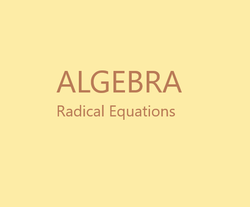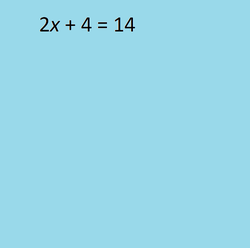A radical equation is one with a square root, cubic root, or any other root.
The method is to isolate the radical on one side of the equation, and raise the expression to the appropriate power so as to remove the radical. A square root is raised to the second power, and so on. Remember, whatever you do to one side of an equation must be done to both sides of the equation.
If there are more than one radical, the process is repeated until all radicals are removed.
Once the radicals are removed, solve the linear or quadratic equation as you normally would.
One added step is needed at the end. Check the answers if the two sides of the equation were raised to an even power. The problem here is that solutions to a squared equation, or any other even power, may or may not solve the original equation.
To illustrate the problem, start with an easy equation, x = 1. We know the solution is 1. Now square each side of the equation. x2 = 1 has two solutions, x = -1 and x = 1. Only one of the solutions works in the original equation.
The problem occurs when raising each side of an equation to an even power. Odd powers do not cause extraneous solutions.
[Note: Because square root symbols added by the equation editor do not appear on this platform I am going to use the 1/2-power as an alternative.]
Do not read between the lines. In some cases, neither solution of the new equation solve the original equation, and in others both solutions work.










 Multivariable Calculus: Gradient, Divergence, and Curl9 days ago
Multivariable Calculus: Gradient, Divergence, and Curl9 days ago
 UAPs, Formerly UFOs, If They Are Real How Can We Explain Their Arrival to Earth?10 days ago
UAPs, Formerly UFOs, If They Are Real How Can We Explain Their Arrival to Earth?10 days ago
 Polar Coordinate System12 days ago
Polar Coordinate System12 days ago
 Aurora Can Disrupt Electrical Devices And Even the Grid?14 days ago
Aurora Can Disrupt Electrical Devices And Even the Grid?14 days ago




Comments
No, the squared equation often has two solutions, but both might solve the original equation, one might and none might. However, there could be more than two,or perhaps only one. In solving the linear equation and the quadratic equation, either of which could occur, there is a set of rules to follow, and if the variable disappears an infinite number of solutions is possible.
blackspanielgallery, Thank you for the practical information and for the product line.
Is there a rule for when even power solves equations and when not?